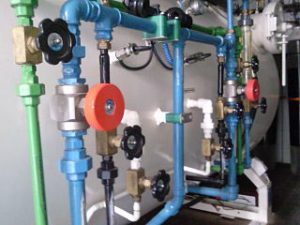 You’ve decided to purchase an above ground storage tank. Or you’ve acquired a business that has one or more already in place. It’s important to understand that the safety and performance of your system depends not just on the tank itself, but on the piping and fittings as well. You don’t need to be dealing with unwanted above ground storage tank spills.
You’ve decided to purchase an above ground storage tank. Or you’ve acquired a business that has one or more already in place. It’s important to understand that the safety and performance of your system depends not just on the tank itself, but on the piping and fittings as well. You don’t need to be dealing with unwanted above ground storage tank spills.
The New York State Department of Environmental Conservation – or your state’s corresponding agency — administers the rules that apply to your above ground storage tank. Specific piping requirements may vary a little, depending on whether your tank falls under the Chemical Bulk Storage Program or the Petroleum Bulk Storage Program, but they are essentially the same in nearly every way.
Your above ground storage tank will perform properly if you follow these five ground rules:
1. General principles.
Piping must be designed, constructed, labeled and protected so that it meets all applicable regulations, with a minimum life of 30 years. All your pipe can run above grade, or some of it can be buried underground.
Either way, the point is to protect groundwater and surface water from contamination, so any part of your system that could leak has to be properly protected. That means you have to provide secondary containment for the piping as well as the tank. You must employ a leak monitoring system, too, again whether your pipes are above ground or underground.
Any new piping you install must be officially inspected before you can put it into service.
2. Special considerations.
Naturally, your piping and the gaskets or joint compound used with it must be compatible with whatever chemicals you’re storing and transferring. You should also physically protect pipes from damage that could occur from moving vehicles or other equipment.
Pipes must be fully protected or resistant to abrasion, vibration, corrosion, shock, expansion and contraction and any likely temperature extremes, whether the source is internal or external. Flexible pipe must be installed to allow movement but also ensure protection from water hammer.
You’ll need a shut-off valve next to each pump or compressor connection, if you have them.
3. Preventing corrosion.
If your piping has contact with soil, it must be corrosion-resistant. Otherwise, you’ll need to team up with a qualified engineer or corrosion specialist to design and construct a cathodic protection and monitoring system. If your system includes pre-fabricated or field-fabricated parts, your professional expert will have to supervise installation, too.
Piping must be isolated from any potential stray electrical current, and you cannot combine any two metals that could then produce a galvanic effect resulting in corrosion.
All piping must be coated on the outside, with fiberglass-reinforced plastic, epoxy or similar material at least 10 mils thick after curing. The goal is a hard shell that is impervious to abrasion, cracking, wicking, softening, flaking or separation and, of course, won’t corrode.
4. Preventing corrosion of above ground pipe.
Even if your pipe is above grade, if it isn’t corrosion-resistant, it must be surface-protected so it won’t corrode or deteriorate. If the pipe diameter is larger than two inches, you must use flanged or welded connectors, or plastic-lined metal pipe with flared-end connectors.
You cannot use threaded connectors if there’s a chance the threads will come in contact with any hazardous chemical. There is one exception — if the gauges or instruments you’re using aren’t available with flanged connectors.
If your above ground storage tank has a dike system and the piping transects the dike wall, pipe must withstand additional stress from fire or settling.
5. Labeling.
You can use a stencil, affixed plate or label, but you must identify the chemical name or common name (whichever is more recognizable) of the product stored in your above ground storage tank. Label all valves, switches and pumps, each end of the piping and both sides of any wall the pipe passes through.
Follow these rules, and your above ground storage tank will have a safe and reliable future. And if you are interested in learning more about Walden Associates, then follow the link.
